In the past
Situation sketches
The criminal justice system which developed from the Revolution and the Napoleonic Code turned the courtroom into an authentic theatre. Artists interpreted the ‘show’ to the public.
Their work, widely reproduced, was multiform: they produced stylized representations, simple decorations for a text or, on the contrary, illustrated accounts consisting of one or several sketches that draw their inspiration from more than the mere narration of the facts.
More than ever, the public image of Justice was transmitted by the artist’s vision.
Image n°1 : The Depré and Norbert Trial.
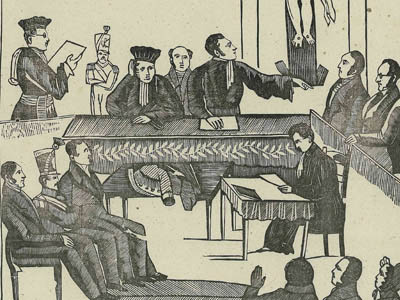
Ordre des avocats de Paris . 1843. Wood print, 20x25,8cm.
January 31, 1843, Depré and Norbert appear before the Assize court in Paris accused of killing and robbing Adolphe Geoffretin, a wheelwright. The text gives the sordid details of the crime, which ended in a double death sentence. Unlike the text, the drawing makes no claim to render the facts with realism. Its value is more symbolic than documentary..
© Ordre des avocats de Paris
Image n°2 : The Trial of Mme Clovis Hugues .
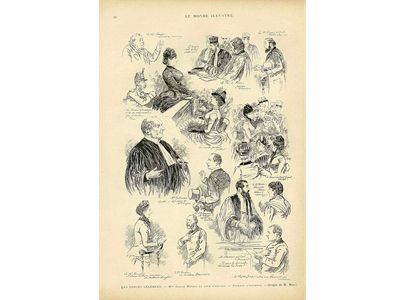
Ordre des avocats de Paris . Le Monde illustré. 17 janvier 1885. 38,5x26cm.
Mme. Hugues was the wife of a politician well-known for his left-wing opinions. A certain Morin strove to dishonour her and persisted in spite of a conviction. Mme. Hugues shot him several times, killing him. She was acquitted by the jury.Mars’s drawings, presented on one page, show all the actors of the trial..
© Ordre des avocats de Paris
Image n°3 : The Gouffé Case.
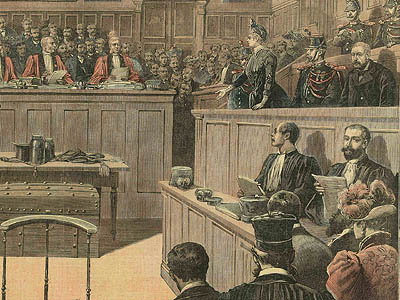
Ordre des avocats de Paris . Le Petit Journal. 20 décembre 1890. 43,9x32cm.
Gouffé was a bailiff who was lured into a trap with a young woman, Gabrielle Bompard, as bait. He was then strangled by her accomplice, Michel Eyraud. Here, the two accused are in the dock. Eyraud, on the right, was condemned to death and executed. Gabrielle Bompard, who is being questioned by the presiding judge of the Assize court, managed to save herself from the guillotine. Among the items of incriminating evidence, behind the box, the trunk in which they had hidden Gouffé’s body. .
© Ordre des avocats de Paris
Image n°4 : The Humbert Case.
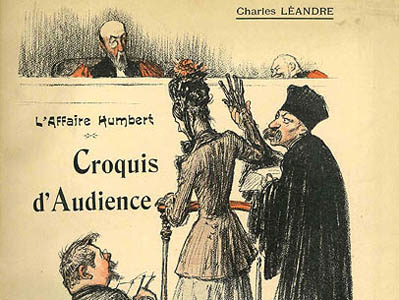
Ordre des avocats de Paris . Courtroom sketch. 1903. 37x27cm.
An artist rarely presents courtroom sketches to the public as artworks in themselves. In 1903, Charles Léandre, who contributed his sketches of Thérèse Humbert’s trial to ‘Le Rire’, published a collection of his drawings in another context. He represents himself busily sketching a witness, so proclaiming the importance of the artist with his own distinctive humour..
© Ordre des avocats de Paris
Image n°5 : Lieutenant Mornet at the Bolo pacha Trial.
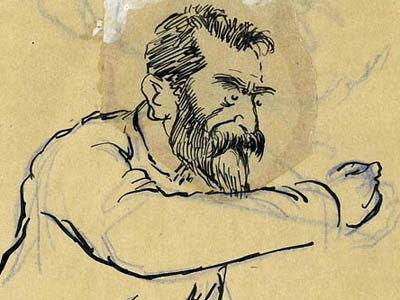
Ordre des avocats de Paris . 1918. Pencil and ink drawings.
Sem attended the hearing when Bolo pacha was tried by the Council of war. The spy was condemned to death and shot for treason. Lieutenant Mornet was prosecuting counsel, as he had been against Mata-Hari and would be later against Maréchal Pétain. Sem did lots of sketches to convey his great oratory talents..
© Ordre des avocats de Paris
Image n°6 : Lieutenant Mornet at the Bolo pacha Trial.
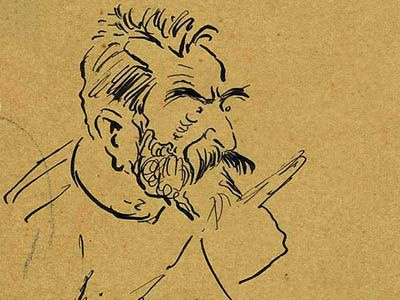
Ordre des avocats de Paris . 1918. Pencil and ink drawings.
Sem attended the hearing when Bolo pacha was tried by the Council of war. The spy was condemned to death and shot for treason. Lieutenant Mornet was prosecuting counsel, as he had been against Mata-Hari and would be later against Maréchal Pétain. Sem did lots of sketches to convey his great oratory talents..
© Ordre des avocats de Paris
Image n°7 : Lieutenant Mornet at the Bolo pacha trial.
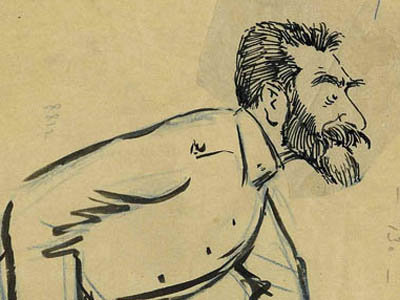
Ordre des avocats de Paris . 1918. Pencil and ink drawings.
Sem attended the hearing when Bolo pacha was tried by the Council of war. The spy was condemned to death and shot for treason. Lieutenant Mornet was prosecuting counsel, as he had been against Mata-Hari and would be later against Maréchal Pétain. Sem did lots of sketches to convey his great oratory talents..
© Ordre des avocats de Paris
Image n°8 : Lieutenant Mornet at the Bolo pacha Trial.
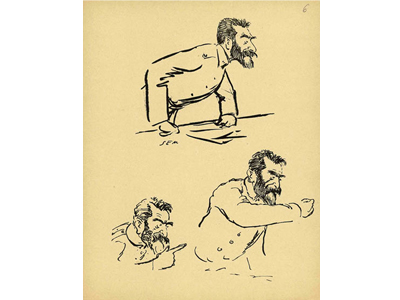
Ordre des avocats de Paris . 1918. Printed montage, 31x25cm.
Sem attended the hearing when Bolo pacha was tried by the Council of war. The spy was condemned to death and shot for treason. Lieutenant Mornet was prosecuting counsel, as he had been against Mata-Hari and would be later against Maréchal Pétain. Sem did lots of sketches to convey his great oratory talents..
© Ordre des avocats de Paris


